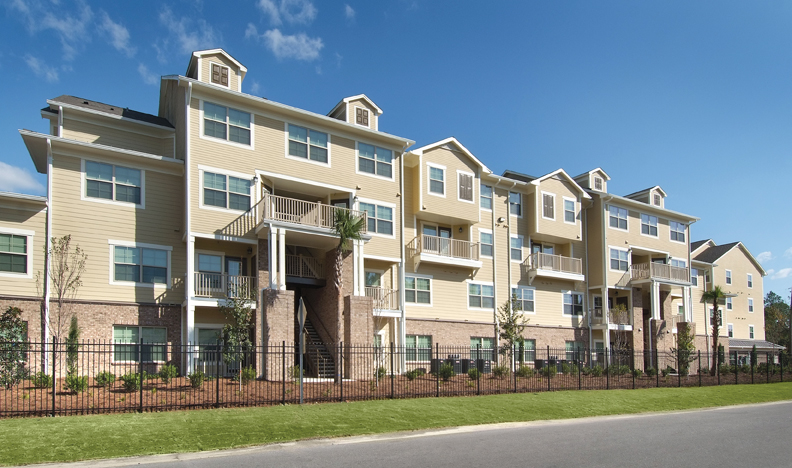As we noted in our July Giants 300 Report, multifamily construction, especially apartment buildings, has been the “darling” of the real estate industry in the last couple of years—and sustainably designed projects are contributing to that boom, even in places you might not think of finding them.
In Portland, Maine, the Oak Street Lofts have become the first affordable multifamily housing to earn LEED Platinum certification in the Pine Tree State. Designed by CWS Architects, the 37 artist-friendly efficiency apartments are 40% more energy efficient than the typical multifamily building. Wright-Ryan Construction (GC) diverted more than 60% of construction waste from landfill.
Thornton Tomasetti/Fore Solutions, acting as sustainability/LEED for Homes consultant, used energy modeling to analyze window glazing types, solar thermal water heating, and a heat-recovery ventilation system, along with envelope design to improve thermal breaks at the exterior wall.
In Panama City, Fla., Hardin Construction teamed with Chap Ashmore & Associates and architect Martin Riley Associates on the 92-unit Panama Commons, the first family-oriented affordable housing community in the Southeast to earn Platinum in the LEED for Homes program.
This was the twelfth project Hardin Construction has completed for the Paces Foundation. Hardin also constructed Galleria Manor, an 88-unit seniors-housing complex in Smyrna, Ga., and Whitehall Manor, in Cleveland, Ga., for the nonprofit housing development corporation. Both projects earned LEED Gold.
Green multifamily developments are also sprouting up in more traditional locales. In New York, construction is under way at 211 East 13th Street on an eight-story condominium development designed by BKSK Architects. The 110,000-sf, 83-unit tower, designed to LEED Silver standards, features a stormwater filtration system—considered unusual for an urban project—and both a blue roof (to store rainwater) and a green vegetated roof to relieve the overtaxed sewer system. +
Related Stories
AEC Tech Innovation | Oct 8, 2024
New ABC technology report examines how AI can enhance efficiency, innovation
The latest annual technology report from Associated Builders and Contractors delves into how artificial intelligence can enhance efficiency and innovation in the construction sector. The report includes a resource guide, a case study, insight papers, and an essay concerning applied uses for AI planning, development, and execution.
Healthcare Facilities | Oct 8, 2024
Herzog & de Meuron completes Switzerland’s largest children’s hospital
The new University Children’s Hospital Zurich features 114 rooftop patient rooms designed like wooden cottages with their own roofs. The project also includes a research and teaching facility.
Mixed-Use | Oct 7, 2024
New mixed-use tower by Studio Gang completes first phase of San Francisco waterfront redevelopment
Construction was recently completed on Verde, a new mixed-use tower along the San Francisco waterfront, marking the end of the first phase of the Mission Rock development. Verde is the fourth and final building of phase one of the 28-acre project that will be constructed in several phases guided by design principles developed by a design cohort led by Studio Gang.
Brick and Masonry | Oct 7, 2024
A journey through masonry reclad litigation
This blog post by Walter P Moore's Mallory Buckley, RRO, PE, BECxP + CxA+BE, and Bob Hancock, MBA, JD, of Munsch Hardt Kopf & Harr PC, explains the importance of documentation, correspondence between parties, and supporting the claims for a Plaintiff-party, while facilitating continuous use of the facility, on construction litigation projects.
Glass and Glazing | Oct 7, 2024
Pattern language: An exploration of digital printing on architectural glazing
Architectural Glazing has long been an important expressive tool which, when selected and detailed thoughtfully, can contribute to the successful transformation of architectural concepts to reality.
University Buildings | Oct 4, 2024
Renovations are raising higher education campuses to modern standards
AEC higher ed Giants report working on a variety of building types, from performing arts centers and libraries to business schools. Hybrid learning is seemingly here to stay. And where possible, these projects address wellness and mental health concerns.
AEC Tech | Oct 3, 2024
4 ways AI impacts building design beyond dramatic imagery
Kristen Forward, Design Technology Futures Leader, NBBJ, shows four ways the firm is using AI to generate value for its clients.
Laboratories | Oct 2, 2024
Trends in scientific research environments: Q&A with Flad's Matt McCord
As part of an ongoing series, Matt McCord, AIA, NCARB, LEED AP BD+C, Associate Principal with Flad Architects, discusses the future of the scientific workplace.
Museums | Oct 1, 2024
UT Dallas opens Morphosis-designed Crow Museum of Asian Art
In Richardson, Tex., the University of Texas at Dallas has opened a second location for the Crow Museum of Asian Art—the first of multiple buildings that will be part of a 12-acre cultural district. When completed, the arts and performance complex, called the Edith and Peter O’Donnell Jr. Athenaeum, will include two museums, a performance hall and music building, a grand plaza, and a dedicated parking structure on the Richardson campus.
Data Centers | Oct 1, 2024
10 biggest impacts to the data center market in 2024–2025
While AI sends the data center market into the stratosphere, the sector’s accelerated growth remains impacted by speed-to-market demands, supply chain issues, and design innovation necessities.

















